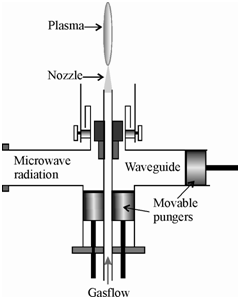Microwave Induced Plasma:
In a microwave induced plasma (MIP) source frequencies in the microwave region are used as external energy source. A microwave radiation of a frequency of 2450 MHz is generally used. Microwave induced plasma is obtained when the ultrahigh frequency ac power is capacitatively coupled into a stream of noble gas (helium or argon) or nitrogen at about 3 dm3 /min. in a resonant cavity.

Figure: A schematic diagram showing the generation of a microwave induced plasma
Low power MIP (50 to 100W) cannot accept solution aerosols without prior desolvation, high power MIP (800W) are more robust and can vaporise and atomise aerosols without desolvation. The MIP is also useful for the excitation of volatile hydride forming elements after stripping the hydrides from the excess of hydrogen. With different trapping techniques, detection limits down to the sub-ng level can easily be obtained.
In one of the microwave plasma torches the microwave power generated by a 2 kW magnetron is guided to the tip of the torch using waveguides. A conical hollow nozzle acts as the tip of the torch through which the plasma gas argon flows. As there is only one flow channel, the sample is also injected through the same. The little size of microwave sources is a benefit over the ICP because it makes it more flexible and less expensive. Therefore, the MIP is found to be inferior to the ICP in respect of detection reproducibility, limits, sensitivity, ionization interference etc. The MIP needs close matching of the calibration and samples solution and very frequent re-calibration is generally required to compensate for large drifts in sensitivity of the MIP. The sample preparation procedures in MIP-AES are also quite tedious and make it an inconvenient analytical method.